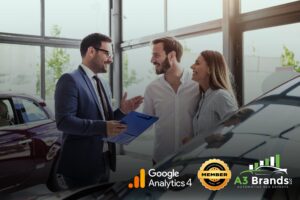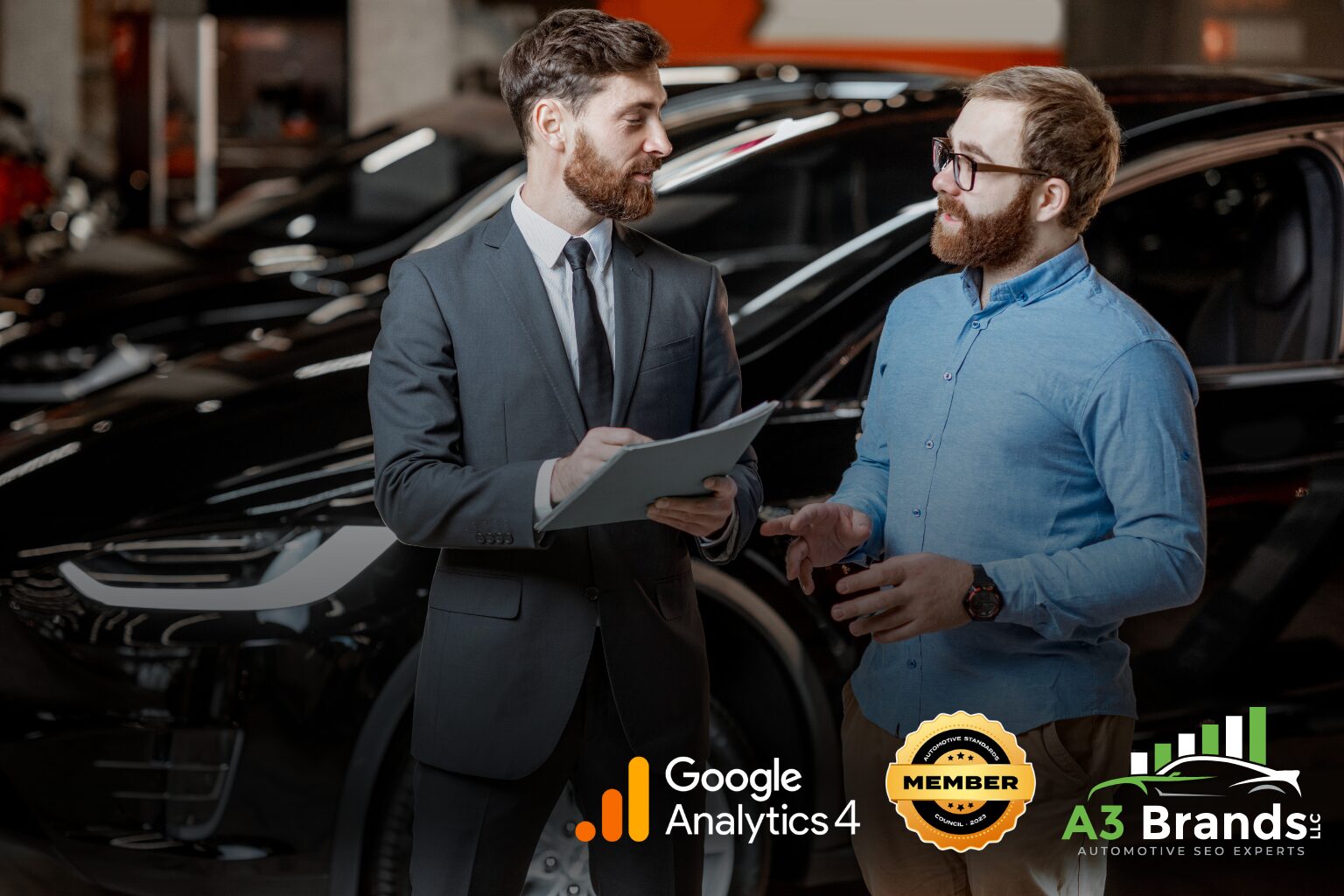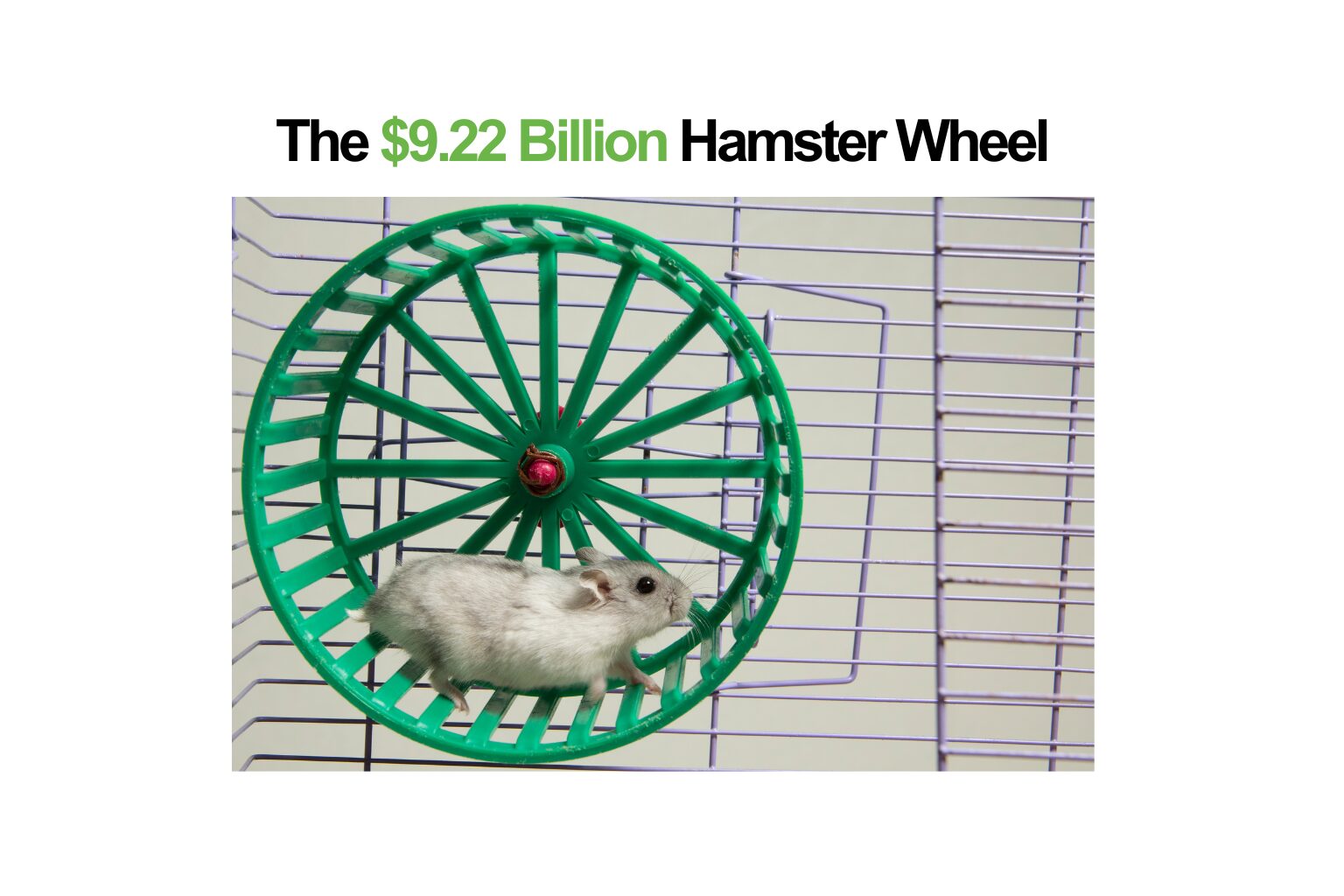Stop Paying Google’s “Stupidity Tax” and Build a Local SEO System That Actually Generates Predictable, Scalable Leads
📑 Table of Contents
- The Uncomfortable Truth Nobody Wants to Say
- The $9.22 Billion Hamster Wheel
- The A3 Brands Contrarian Take: Paid Search Is a Tax on Bad SEO
- The Real Problem: You’re Treating Local SEO Like a Task
- What Actually Works: The A3 Brands Localization System
- The #1 Ranking in 3 Weeks (Yes, Really)
- Google Discover: 6,000 Clicks and 180,000 Impressions
- What Our Clients Actually Say
- The Metric That Actually Matters: Organic CAC
- The Content Formula That Scales: 60-30-10
- Implementation: How This Actually Happens
- The Bottom Line
- Here’s What Happens Next
Let’s talk about the elephant in the showroom.
The average dealership spent $543,539 on advertising in 2024. For multi-location groups with 10+ stores, you’re easily burning through $5-10 million annually.
Here’s the gut-punch: 43% of your qualified leads are being mishandled, with 13.1% never even making it into your CRM. You’re paying $42.52 per lead, then watching nearly half of them leak out like a sieve.
But that’s not even the worst part.
The worst part is that you already own the solution and you’re ignoring it.
The Uncomfortable Truth Nobody in Automotive Marketing Wants to Say
I’m going to lose some friends for saying this, but somebody needs to:
Most multi-location dealership groups are running their local SEO like it’s 2012. And it’s costing you a fortune.
You’ve got 15 locations. Maybe 30. Maybe 50. Each one has a Google Business Profile that—if you’re lucky—got set up by someone who no longer works for you. Your location pages? They’re the same template with find-and-replace city names. Your citations are a mess. Half your stores show up in the local 3-pack. The other half? Invisible.
Meanwhile, you’re dumping $105,256 on average into search engine marketing every year—per location—trying to buy visibility you should already own organically.
Here’s what kills me: If you rank in Google’s local 3-pack, you get 126% more traffic and 93% more customer actions than positions 4-10. That’s not a marginal difference. That’s a business-altering difference.
So why are half your locations buried on page two?
The $9.22 Billion Hamster Wheel
Here’s how the game works right now:
U.S. dealerships collectively spent $9.22 billion on advertising in 2024. That’s billion, with a B.
73% of that went to digital. The biggest chunks? Third-party listing sites ($109,487 average per store), search engine marketing ($105,256), and SEO website optimization ($103,140).
Translation: You’re paying hand-over-fist to rent visibility on platforms you don’t control, while the asset you actually own—your organic search presence—sits there collecting dust.
It’s like renting a car when you’ve got a Ferrari in your garage. Except the Ferrari is missing three wheels and nobody bothered to check.
The A3 Brands Contrarian Take: Paid Search Is a Tax on Bad SEO
Look, I’m not saying kill your paid budget tomorrow. That would be stupid.
What I am saying is this: Every dollar you spend on paid search for branded terms and local intent keywords is a dollar you’re spending because your organic presence is broken.
Organic search drives 53% of all website traffic. When someone searches “Ford dealer [your city]” and you’re not showing up organically, you’re paying for a failure you created.
Here’s what we’ve proven with our clients: When you fix the foundation, paid spend becomes optional instead of mandatory.
One of our Internet Directors put it this way: “When A3 Brands first approached me about focusing on my website’s SEO instead of paying Google’s CPC for my own name, I was excited to say the least… I couldn’t be happier with A3 Brands performance and for significantly less money than what I was paying Google in ‘Cost per Click’ fees. Our dealership now ranks first on Google 24 hours per day, 7 days per week.”
Translation: They stopped paying Google to show up for their own branded terms. And they’re not alone.
The Real Problem: You’re Treating Local SEO Like a Task, Not a System
Every multi-location group I audit has the same pattern:
- Springfield location: Manager is an SEO ninja. Profile is perfect. Reviews flowing. Crushing it.
- Riverside location: Profile was claimed three years ago. Last post: June 2022. Photos from when Obama was president.
- Westfield location: Two Google Business Profiles. Neither one is right. NAP doesn’t match the website.
This isn’t local SEO. This is chaos with a branded color scheme.
You wouldn’t let each location set their own prices, write their own ads, or invent their own sales process. But somehow, SEO is the Wild West.
Here’s what nobody tells you: Multi-location local SEO is an operational problem, not a marketing problem. And operational problems need systems, not hope.
What Actually Works: The A3 Brands Localization System
After 20 years in automotive SEO, here’s what we know works:
1. Centralized Control with Bounded Local Flexibility
Corporate owns:
- Technical infrastructure (site architecture, schema, APIs)
- Brand standards (what CANNOT change)
- Attribution and measurement (deterministic tracking)
Local stores own:
- Community content (within pre-approved frameworks)
- Review generation execution
- Local event promotion
Real result: We helped Davis Acura elevate their online presence through a tailored SEO strategy that focused on key areas crucial to the automotive industry. The results? Outstanding increases in lead generation and measurable revenue growth.
For four other dealerships we worked with, our tailored SEO strategies delivered remarkable increases in key event conversions. Enhanced search visibility and user engagement translated directly into measurable revenue growth.
2. Google Business Profile: Stop Leaving Money on the Table
86% of all Google Business Profile views come from category searches—people typing “Toyota dealer near me” or “used cars open Saturday.”
These are the highest-intent shoppers in your market. They’re not browsing. They’re buying.
If your profile isn’t optimized, you’re invisible to them.
What “optimized” actually means:
- Verified profile for every location (non-negotiable)
- Perfect NAP consistency (one character off tanks your credibility)
- Weekly posts (inventory drops, service specials, local events)
- Real photos (not stock images from 2015)
- Active review generation and 24-hour response protocol
We automate 90% of this for our clients. Why? Because asking 30 location managers to manually update profiles every week doesn’t work. People get busy. Standards slip. Your organic visibility tanks.
3. Content That Converts: The 323% Increase Story
Your location pages right now probably look like this:
“Welcome to [CITY NAME] Ford! We’re your trusted [CITY NAME] Ford dealer serving [CITY NAME] and surrounding areas. Visit our [CITY NAME] location today!”
Google sees through this garbage. So do customers.
Here’s what actually works: Our innovative content strategy nearly doubled lead generation for one auto dealership by driving high-quality organic traffic. We achieved a 323% increase in blog clicks and shifted the lead mix toward phone leads—which means customers weren’t just browsing, they were ready to buy.
This approach enhanced user engagement, built trust, and prompted immediate action, leading to substantial sales opportunities.
In another case, we leveraged strategic keyword research and created high-value content that became the dealership’s second most-trafficked page. This single effort significantly boosted conversions, doubling customer interactions and solidifying their market presence.
Technical stuff that matters:
- Clean URL structure: yoursite.com/locations/city-name
- Proper schema markup (LocalBusiness, AutoDealer, Vehicle, Offer)
- Mobile-first everything (your traffic is on phones)
- Core Web Vitals compliance (speed matters)
4. Citations: The Boring Work That Prints Money
Nobody wants to talk about citations. They’re tedious. They’re unsexy.
They’re also worth 15-20 local pack positions when you clean them up.
Our approach:
- Centralized master database (one source of truth)
- Automated distribution to aggregators (Neustar Localeze, Data Axle)
- Continuous monitoring for rogue listings
- Tier 1 directories (Google, Apple, Bing, Facebook) = daily monitoring
- Tier 2 directories = weekly audits
We’ve had clients jump 15-20 positions in local pack just from citation cleanup. That’s free money sitting on the table.
5. Reviews: The Trust Signal You Can’t Fake
You can’t fake social proof. But you can systematize how you generate it.
Our playbook:
- Automated triggers at customer milestones (delivery, service pickup, parts purchase)
- Multi-channel outreach (SMS first, email backup, final reminder)
- Response templates that require personalization (no robot responses)
- Sentiment monitoring with NLP (catch problems before they explode)
Pro tip: Respond to every review within 24 hours. This isn’t optional. Google measures engagement velocity and response rates when determining local pack rankings.
The #1 Ranking in 3 Weeks (Yes, Really)
Here’s where most SEO agencies will tell you it takes 6-12 months to see results. And for most of them, that’s true—because they don’t know what they’re doing.
Listen to what one of our General Managers said:
“To say I was skeptical when A3 told me they could get our dealership to the #1 SEO ranking on Google for transactional terms within 3 weeks is an understatement. I’ve been told repeatedly how it takes months to build out an SEO campaign on Google to get your dealership to rank in the top 3 positions. Well, I am now a firm believer in the ability of A3 Brands to do exactly that. Within 3 weeks our top 5 models were and still are ranking in the #1 SEO position on Google in the largest demographic area we participate in.“
This isn’t magic. This is 20 years of automotive SEO experience knowing exactly which levers to pull and in what order.
Google Discover: 6,000 Clicks and 180,000 Impressions
Most dealerships have never even heard of Google Discover, let alone optimized for it.
Google Discover is the feed that shows up on mobile devices—it’s how millions of people discover content without even searching for it. It’s algorithmic, it’s powerful, and most dealerships are completely ignoring it.
We leveraged engaging, relevant content to drive over 6,000 clicks and 180,000 impressions on Google Discover for one of our clients, dramatically expanding their audience reach.
Our strategic SEO approach directly impacted business growth, boosting primary conversions from around 200 to over 600 within just six months.
That’s a 200% increase in conversions. In six months.
What Our Clients Actually Say
From an Internet Sales Manager with 7 years in the industry:
“I have to say A3 Brands, LLC is, by far, THE BEST SEO company I’ve worked with in my 7 years as an Internet Sales Manager in the auto industry. There really is no comparison and I’ve worked with several companies in the past that claimed to be ‘SEO’. Multiple landing pages built, blogs written constantly, their content is informative, efficient, creative, and EFFECTIVE! They have absolutely no problem showing their attribution to website engagement either which is a huge plus… weekly and/or monthly reporting is given along with scheduled meetings to review performance.”
From an Internet Director in Florida:
“We just had A3 Brands install their SEO Program a few months ago and it is already working. Me and my Internet Staff have noticed an increase in quality leads that have already resulted in an increase in sales.”
Notice a pattern? They’re not talking about “increased traffic” or “better rankings” in the abstract. They’re talking about quality leads that turn into sales.
That’s the difference between SEO as a vanity metric and SEO as a revenue driver.
The Metric That Actually Matters: Organic Customer Acquisition Cost (CAC)
Here’s where most dealerships completely fall apart: they have no idea what organic search costs them per lead.
They know their paid CAC down to the penny. But organic? “It’s free traffic!”
No. It’s not free. You’re paying for it in salary, technology, and agency fees. The question is: is it cheaper than paid?
We instrument everything:
- Dynamic Number Insertion (DNI) for phone tracking
- UTM parameters on every form submission
- CRM lead-matching to tie back to source
- Multi-touch attribution (car buying isn’t linear)
In our experience with automotive clients:
- Organic leads convert 20-30% higher than paid leads
- Organic CAC runs 40-60% lower than paid CAC
- Customer lifetime value is 15-25% higher (they’re not price-shopping, they found YOU)
Quick definition: Customer Acquisition Cost (CAC) is how much you spend in marketing and sales to acquire one customer. If you spend $100,000 on advertising and get 100 sales, your CAC is $1,000 per customer. The lower your CAC, the more profitable each sale becomes.
The Content Formula That Scales: 60-30-10
How do you create unique content for 30+ locations without hiring an army of writers?
Our framework:
- 60% corporate content: Brand voice, major promos, product education (created once, deployed everywhere)
- 30% regional content: Market-specific angles, local events, regional offers (created at regional level)
- 10% hyperlocal content: Store-level stories, team spotlights, community involvement (created by local managers)
This keeps your brand consistent while giving local teams enough rope to connect authentically with their communities.
And it scales. We’ve deployed this across multi-location groups without breaking a sweat.
Implementation: How This Actually Happens
Weeks 1-4: Foundation
- Technical audit across all locations
- API access setup (GBP, GA4, Search Console, your DMS)
- Data warehouse configuration
- Governance documentation and role assignments
- Schema implementation and XML sitemaps
- Attribution pipeline setup
Weeks 5-8: Execution
- Citation audit and systematic cleanup
- Location page builds with dynamic modules
- Review generation workflows activated
- Content production cycles launched
- Staff training (with actual documentation)
Weeks 9-12: Measurement & Iteration
- Performance comparison to baseline
- Organic CAC calculation by location
- Process refinement based on data
- Scale plan development
The Bottom Line
Multi-location local SEO isn’t complicated. It’s disciplined.
The dealership groups dominating local search aren’t smarter than you. They just stopped treating SEO like a side hustle and started treating it like operational infrastructure.
At A3 Brands, we’ve spent 20 years building that infrastructure for automotive dealerships.
We give you centralized control to protect your brand, standardized processes to ensure consistency, and local flexibility to win in specific markets.
Most importantly, we make your organic performance budgetable and predictable. Not a hope-based strategy. An actual line item you can measure, forecast, and scale.
Here’s What Happens Next
You’ve got three choices:
Option 1: Keep doing what you’re doing. Keep spending $500K+ per year on advertising. Keep watching 43% of your leads leak out. Keep hoping your organic presence magically improves.
Option 2: Try to build this yourself. Hire a couple people. Spend 18 months learning what doesn’t work. Maybe get it right eventually. Maybe don’t.
Option 3: Work with people who’ve been doing this for 20 years in automotive. Pick 3-5 representative locations. Run a 60-day pilot with full attribution tracking. See exactly what’s possible when you stop renting visibility and start owning it.
If the pilot shows the CAC reduction we’re talking about, scale it. If it doesn’t, you’ve lost 60 days and learned something valuable.
But here’s the thing: While you’re deciding, your competitors are implementing. The dealership groups that master local SEO in 2025 will own their markets. The ones that don’t will keep paying the paid-search tax forever.
Your move.
Ready to stop bleeding money on paid search?
Let’s talk specifics. The A3 Brands team has 20 years of automotive SEO experience across different markets, DMS systems, and competitive landscapes.
We’ll map our localization platform to your exact situation and show you what’s possible when you treat local SEO like the operational asset it actually is.
Contact A3 Brands today. Let’s turn your local SEO from a hope-based strategy into a revenue engine.
No long-term contracts. No risk. Just a proven framework that either delivers data-backed results or you walk away.
📊 Verified Statistics Referenced in This Article:
- Average dealership advertising spend: $543,539 (2024 NADA data)
- Total U.S. dealership ad spend: $9.22 billion (2024)
- 43% of qualified leads mishandled, 13.1% never logged in CRM
- Average dealership CAC: $42.52 per lead
- Average SEM spend: $105,256 per dealership
- Third-party listing sites: $109,487 average spend
- Local 3-pack receives 126% more traffic, 93% more actions than positions 4-10
- 86% of GBP views from category searches
- Organic search drives 53% of website traffic
- Review engagement and response rates impact local rankings
🎯 Real A3 Brands Client Results:
- Davis Acura: Outstanding lead generation increase and measurable revenue growth
- Four dealerships: Remarkable key event conversion increases
- Content strategy: 323% increase in blog clicks, nearly doubled lead generation
- Strategic content: Became second most-trafficked page, doubled customer interactions
- Google Discover: 6,000+ clicks, 180,000 impressions, 200% conversion increase (200→600 in 6 months)
- #1 ranking achieved in 3 weeks for top 5 models in largest demographic area
Tim Boyle
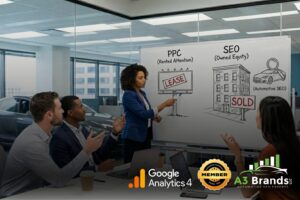
What Your PPC Bill Isn’t Telling You: The Real Math Behind SEO vs Paid Search
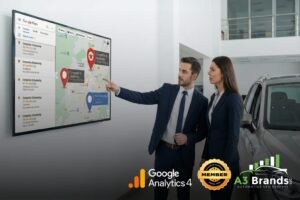
Why Your Competitor Ranks Higher (And How to Close the Gap)

Your 2026 Digital Roadmap: 3 Data-Backed SEO Shifts Every GM Must Make

Why Dealers Who Started Content Marketing in 2022 Now Pay 40% Less Per Lead
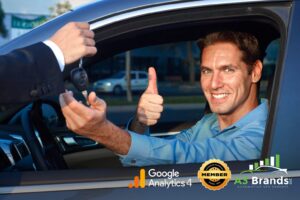
How Dealerships Win Search in 2026 Without Wasting Money on Clicks
